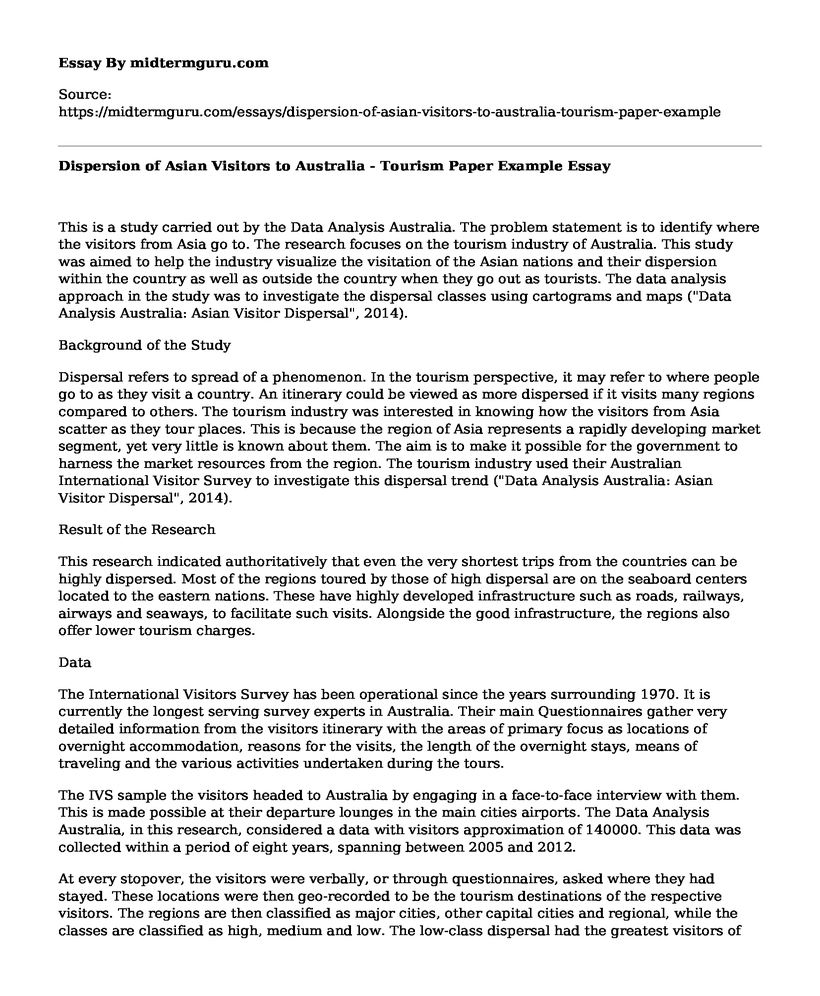This is a study carried out by the Data Analysis Australia. The problem statement is to identify where the visitors from Asia go to. The research focuses on the tourism industry of Australia. This study was aimed to help the industry visualize the visitation of the Asian nations and their dispersion within the country as well as outside the country when they go out as tourists. The data analysis approach in the study was to investigate the dispersal classes using cartograms and maps ("Data Analysis Australia: Asian Visitor Dispersal", 2014).
Background of the Study
Dispersal refers to spread of a phenomenon. In the tourism perspective, it may refer to where people go to as they visit a country. An itinerary could be viewed as more dispersed if it visits many regions compared to others. The tourism industry was interested in knowing how the visitors from Asia scatter as they tour places. This is because the region of Asia represents a rapidly developing market segment, yet very little is known about them. The aim is to make it possible for the government to harness the market resources from the region. The tourism industry used their Australian International Visitor Survey to investigate this dispersal trend ("Data Analysis Australia: Asian Visitor Dispersal", 2014).
Result of the Research
This research indicated authoritatively that even the very shortest trips from the countries can be highly dispersed. Most of the regions toured by those of high dispersal are on the seaboard centers located to the eastern nations. These have highly developed infrastructure such as roads, railways, airways and seaways, to facilitate such visits. Alongside the good infrastructure, the regions also offer lower tourism charges.
Data
The International Visitors Survey has been operational since the years surrounding 1970. It is currently the longest serving survey experts in Australia. Their main Questionnaires gather very detailed information from the visitors itinerary with the areas of primary focus as locations of overnight accommodation, reasons for the visits, the length of the overnight stays, means of traveling and the various activities undertaken during the tours.
The IVS sample the visitors headed to Australia by engaging in a face-to-face interview with them. This is made possible at their departure lounges in the main cities airports. The Data Analysis Australia, in this research, considered a data with visitors approximation of 140000. This data was collected within a period of eight years, spanning between 2005 and 2012.
At every stopover, the visitors were verbally, or through questionnaires, asked where they had stayed. These locations were then geo-recorded to be the tourism destinations of the respective visitors. The regions are then classified as major cities, other capital cities and regional, while the classes are classified as high, medium and low. The low-class dispersal had the greatest visitors of 62%. Medium dispersal class had 22% of the visitors. Only a small portion of the visitors spent their time in the regions classified as regional. This indicates that, though the dispersal may be used as a means of distributing economic resource of tourism among the community, and especially the regional areas, it is ineffective and limited at the time of the study (Tourism Research Australia, 2017).
Opinion about the Study
This study is a sophisticated one that requires highly developed research tool to help achieve the goals without significant error margins. This is where the course on computer statistics comes in to ease the work for better results. The research also lacks proper population representation since the sample dealt with is too small compared to the time frame of the study and the small sample size sometimes does not necessarily give an overview of a large region. The study was performed to help the Tourism Industry of Australia plan for the tourists as well as in assessing the tourism growth target.
References
Data Analysis Australia: Asian Visitor Dispersal. (2014). Tourism Research Australia. Retrieved 26 February 2017, from http://www.daa.com.au/case-studies/asian-visitor-dispersal/
Tourism Research Australia, (2017). INTERNATIONAL VISITORS TO HELP AUSTRALIAN TOURISM HIT THE MARK. Retrieved from http://www.tra.gov.au/documents/media-releases/MR_Forecast_2016.pdf
Cite this page
Dispersion of Asian Visitors to Australia - Tourism Paper Example. (2021, Jun 07). Retrieved from https://midtermguru.com/essays/dispersion-of-asian-visitors-to-australia-tourism-paper-example
If you are the original author of this essay and no longer wish to have it published on the midtermguru.com website, please click below to request its removal:
- The Importance of the Mobile Application and Related Technologies in Tourism
- Essay on Sports Tourism Versus Medical Tourism
- Egyptian Pyramids - Essay Example
- Letter From Manager of Sagami Tei Restaurant
- Tragic End of Alaska Airlines Flight 261 - Case Study
- Tourism: Leisure, Sightseeing & Residing at Resorts - Essay Sample
- Marine Debris: The Scourge of Petone Beach Tourism







